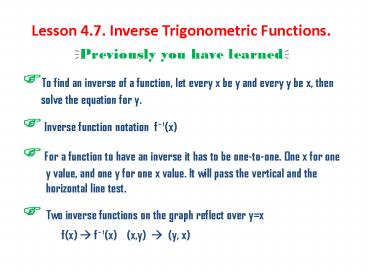Lesson 4.7. Inverse Trigonometric Functions. - PowerPoint PPT Presentation
Title:
Lesson 4.7. Inverse Trigonometric Functions.
Description:
Lesson 4.7. Inverse Trigonometric Functions. Previously you have learned To find an inverse of a function, let every x be y and every y be x, then solve the ... – PowerPoint PPT presentation
Number of Views:268
Avg rating:3.0/5.0
Title: Lesson 4.7. Inverse Trigonometric Functions.
1
Lesson 4.7. Inverse Trigonometric Functions.
- ?Previously you have learned?
- ?To find an inverse of a function, let every x be
y and every y be x, then solve the equation for
y. - ? Inverse function notation f¹(x)
- ? For a function to have an inverse it has to be
one-to-one. One x for one y value, and one y
for one x value. It will pass the vertical and
the horizontal line test. - ? Two inverse functions on the graph reflect over
yx - f(x) ? f¹(x) (x,y) ? (y, x)
2
(No Transcript)
3
(No Transcript)
4
- Sometimes you just dont have a nice or
convenient - algebraic process that will give you an inverse
function. Many functions need a special, new rule
for their inverse. Some examples of these
functions are
5
- FINDING INVERSE OF A TRIG FUNCTION
- Given f(x) sin (x)
- y sin (x) change f(x)
for y - x sin (y) switch xs and ys
- y arcsin (x) solve for y
- f¹(x) arcsin (x) write using function
notation - f¹(x) sin¹(x)
Inverse Trigonometric function notation
Inverse sine Inverse cosine
Inverse tangent
6
- FINDING INVERSE OF A TRIG FUNCTION ALGEBRAICALLY
- Given y sin (x)
- - ½ sin ( -p/6) sin (-p/6) - ½
- (-p/6) sin (- ½ ) switch x and
y values - (-p/6) arcsin ( - ½ ) solve for y
- (-p/6) sin¹( - ½ ) sin¹( - ½ )
(-p/6) - How does this look on the graph ??
7
Graphing Inverse Trigonometric functions
- The graph of y sin x
- D all reals R -1,1 Period 2p
Y-int.(0,0) - this function is not one-to-one (different x
values yield the same y) - with domain restricted to -p/2 p/2 y sin x
is one-to one - therefore, we can use this piece to finds its
inverse
8
(No Transcript)
9
Using the domain restricted to -p/2 p/2
lets graph y arcsin x Remember that y
arcsin x is equivalent to sin y x
X y-values of sin x
y arcsin x x values of sin x
10
(No Transcript)
11
Graphs of inverse functions
- The graph of y arc sin x
Domain
Range
12
NEXT ON THE LIST
- ARCCOSINE
- Sketch the common curve of y cos x
- Select interval of the cosine that will be
one-to-one - Sketch the graph of arccosine
13
The chosen section for the cosine is in the red
frame. This section includes all outputs from 1
to 1 and all inputs in the first and second
quadrants.
14
Graphs of inverse functions
- The graph of y arccos x
Domain
Range
15
The other trig functions require similar
restrictions on their domains in order to
generate an inverse.
yarctan(x)
ytan(x)
16
Graphs of inverse functions
- The graph of y arctan x
Domain
Range
17
The table below will summarize the parameters we
have so far. Remember, the angle is the input for
a trig function and the ratio is the output. For
the inverse trig functions the ratio is the input
and the angle is the output.
arcsin(x) arccos(x) arctan(x)
Domain
Range
When xlt0, yarcsin(x) will be in which quadrant?
ylt0 in IV
When xlt0, yarccos(x) will be in which quadrant?
ygt0 in II
ylt0 in IV
When xlt0, yarctan(x) will be in which quadrant?
18
Evaluating Inverse Trigonometric Functions
algebraically.
- When evaluating inverse trigonometric functions,
you are looking for the angle whose (insert
sin, cos, or tan) is x. Also, keep in mind the
domain and range of each function. - Find the exact value for
- Solution
- For what value of x is sin (x) ?
- Sin ( p/3) therefore
19
Evaluating Inverse Trigonometric Functions
algebraically.
- Find the exact value for
- Solution
- For what value of x is cos (x) ?
- Cos ( 3p/4) therefore
20
(No Transcript)
21
(No Transcript)
22
(No Transcript)
23
(No Transcript)
24
(No Transcript)

